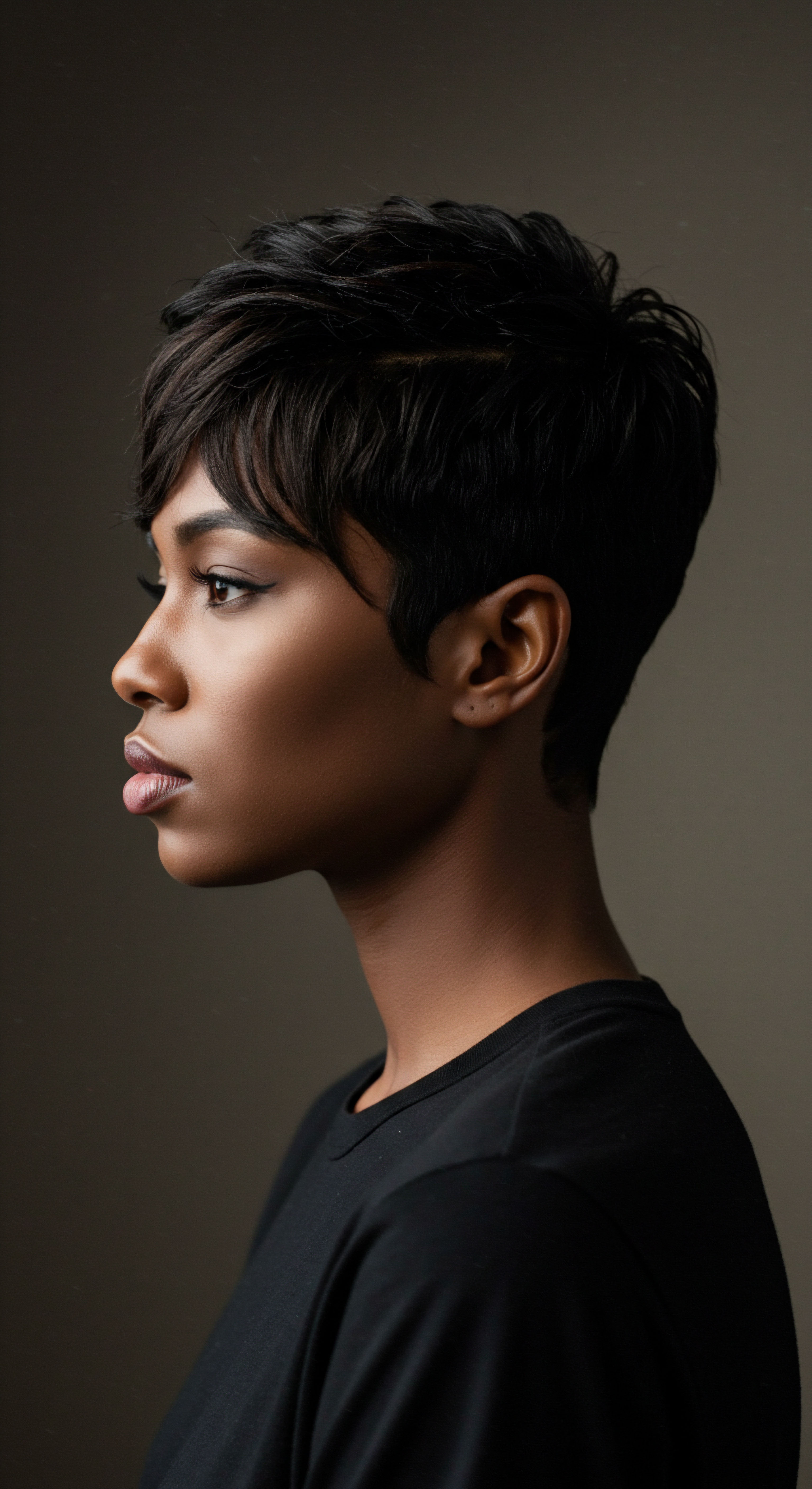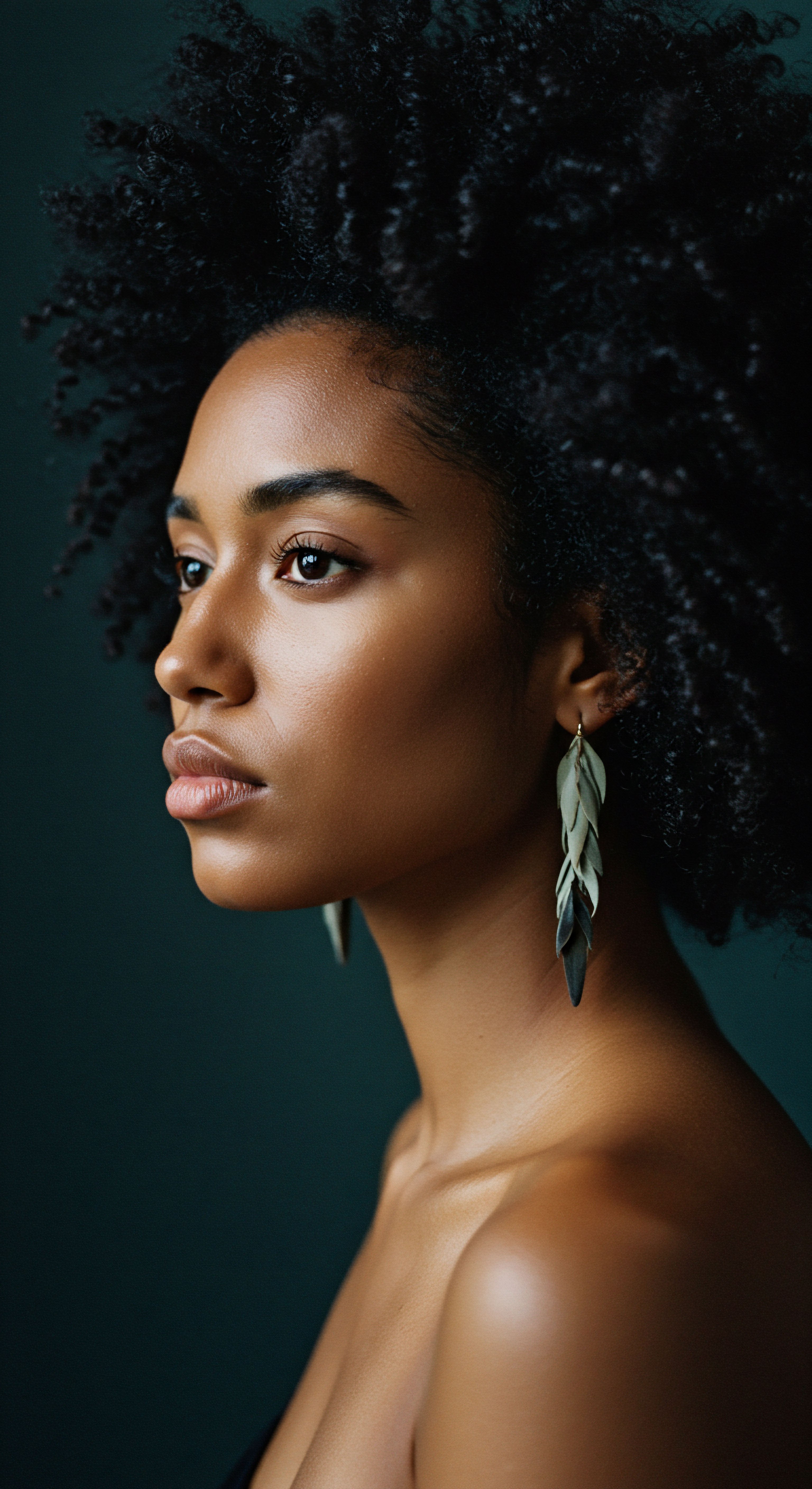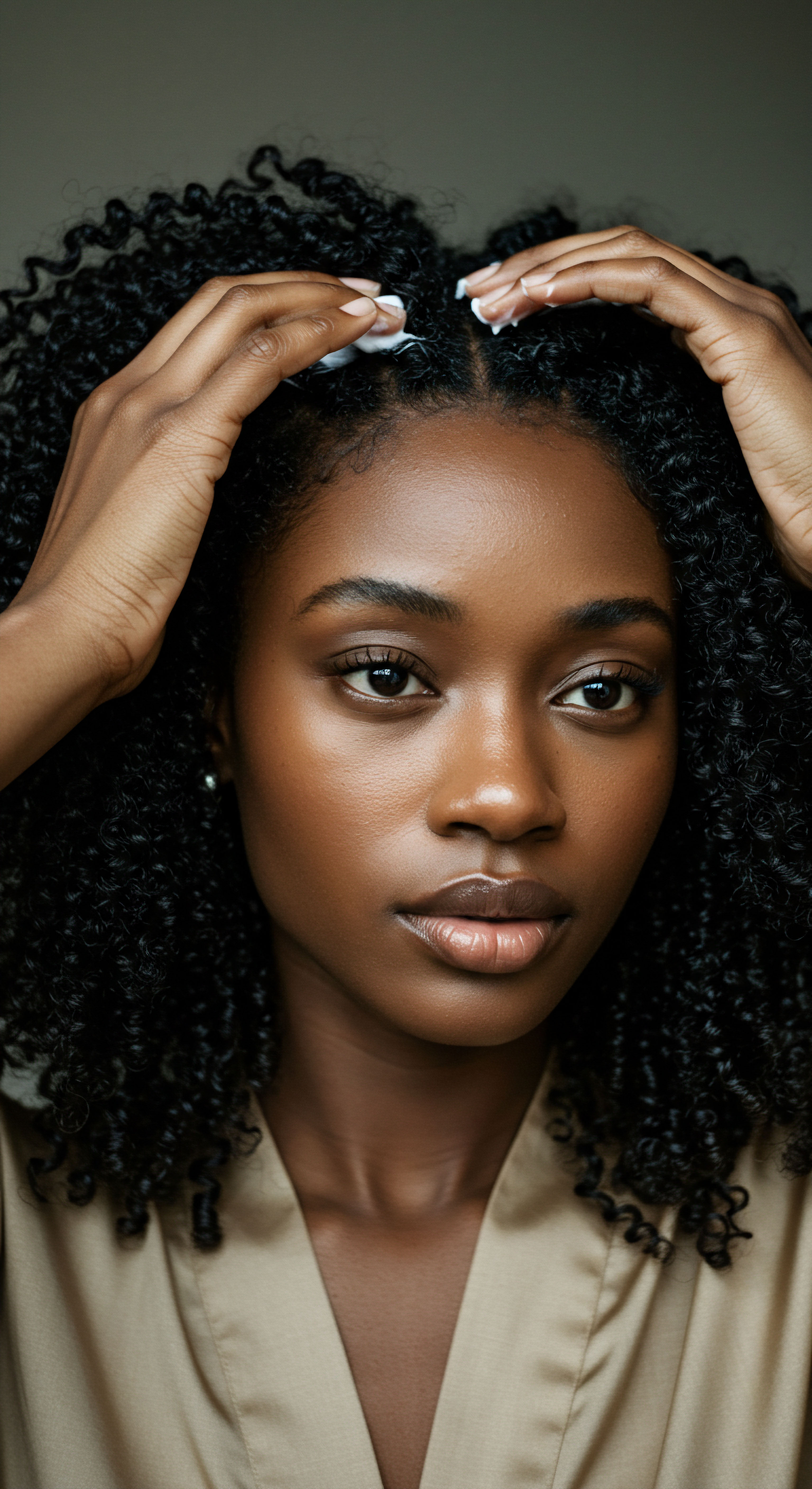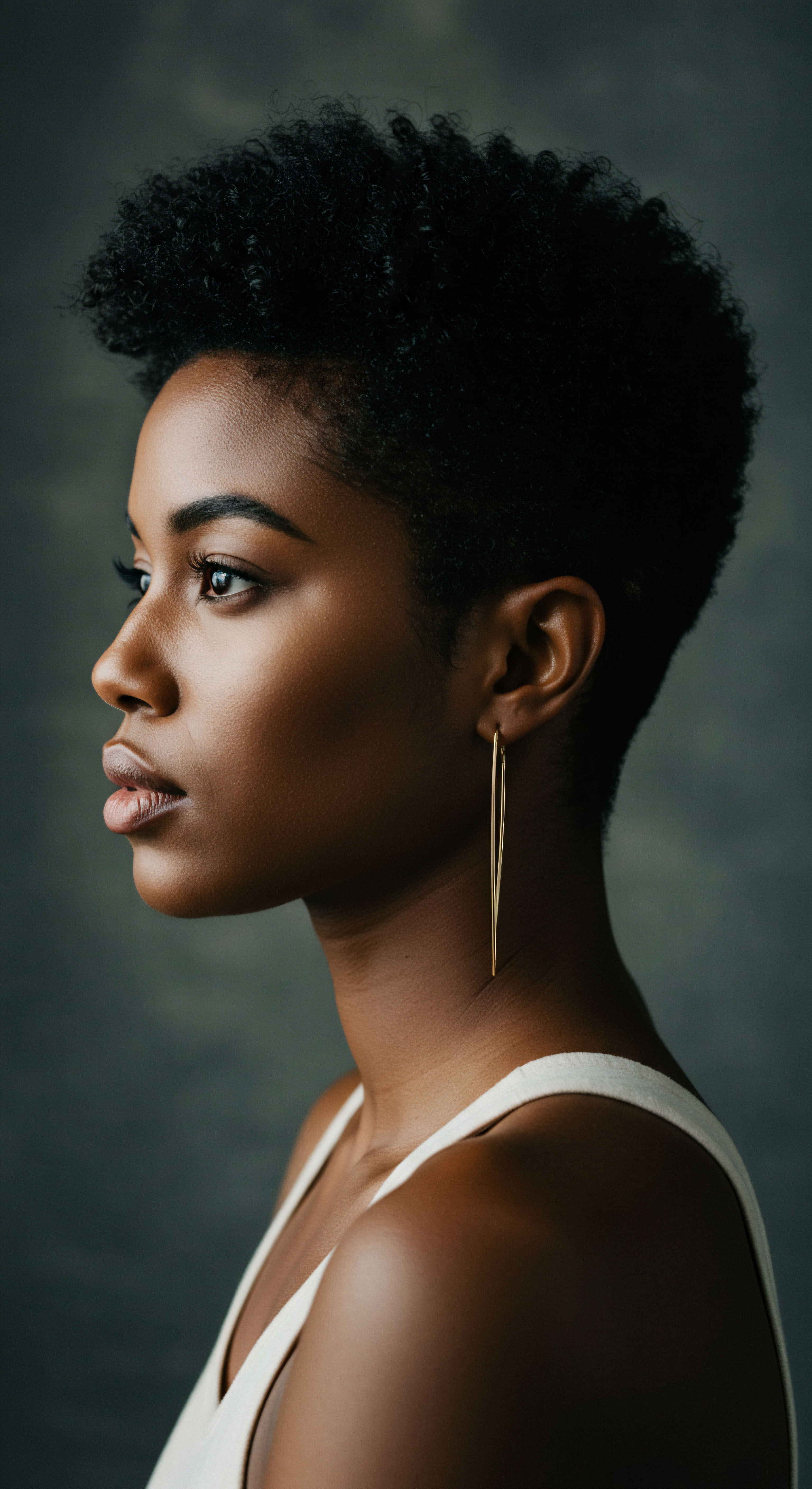
Roots
Our strands, each a delicate filament, hold stories within their very architecture. They speak of lineage, of daily rituals passed through generations, and of the intricate dance between our inner landscape and the world outside. There exists a quiet wonder in observing how hair responds to our touch, to the elixirs we choose, and to the very air it breathes.
A frequent contemplation among those who tend to textured tresses centers on porosity ❉ Can this fundamental characteristic, so often presented as a fixed truth, truly shift over time through dedicated attention? To approach this contemplation, we must first recognize the hair’s elemental composition, its foundational blueprint.
At the microscopic level, each hair strand is a marvel of biological engineering. It springs from the scalp, a living entity for a brief period, then extends as a non-living protein filament. The outermost layer, the cuticle, resembles a shingled roof, composed of overlapping scales. The condition of these scales, whether tightly sealed or slightly lifted, largely determines what we call porosity.
Low Porosity hair possesses cuticles that lie flat and compact, resisting moisture absorption but retaining it well once absorbed. High Porosity hair features cuticles that are more open, sometimes due to genetic predisposition or external stressors, readily taking in moisture but also releasing it with ease. Medium Porosity hair strikes a balance, its cuticles neither overly open nor overly sealed.
The core of this inquiry lies in discerning the difference between a hair strand’s inherent, genetic makeup and its responsiveness to environmental factors and consistent care. Hair, while appearing static, is a dynamic system. Its outer surface, the cuticle, constantly interacts with its surroundings.
The oils we apply, the water we use for cleansing, the very humidity in the atmosphere – all these play a role in the cuticle’s temporary state. This interaction influences how easily substances pass into or out of the hair shaft.
Hair’s outer cuticle layer dictates its porosity, a quality influenced by both genetic predisposition and environmental factors.
Consider the impact of the hair’s outermost shield, the cuticle. Its integrity is paramount. When these protective scales are smooth and tightly bound, the hair feels sleek and appears lustrous. When they are ruffled or damaged, the hair can feel rough and appear dull.
This surface condition is what we perceive as porosity in our daily experience. It is the hair’s initial response to moisture, a direct reflection of its cuticle’s current disposition.

What Is Hair Porosity and How Is It Measured
Hair porosity describes the hair’s ability to absorb and retain moisture. It is not a single, static measure but rather a spectrum. The widely recognized ‘float test’ – placing a clean strand of hair in a glass of water – offers a rudimentary home assessment. A strand that sinks quickly often indicates higher porosity, while one that floats suggests lower porosity.
While a helpful guide, this method provides only a superficial reading. More precise evaluations, often performed by trichologists, consider the hair’s response to various products and its overall texture. They might use specialized tools to examine cuticle integrity under magnification.
The genesis of one’s hair porosity is often a gift of genetics. Some individuals are simply born with hair that naturally possesses a more open cuticle structure, predisposing them to higher porosity. Others inherit strands with a naturally compact cuticle, leading to lower porosity. This genetic blueprint lays the initial groundwork.
However, the story does not end there. Environmental aggressors and styling practices significantly contribute to how this inherent porosity manifests and behaves over time.
- Low Porosity Hair tends to resist water, requiring patience for saturation.
- High Porosity Hair absorbs water quickly, yet releases it with equal speed.
- Medium Porosity Hair finds a harmonious equilibrium in moisture absorption and retention.

Can Environmental Stressors Influence Hair Porosity
Indeed, the daily life of our hair is a continuous interplay with its surroundings. Sun exposure, harsh winds, and even the mineral content in our tap water can stress the cuticle. These external elements, over time, contribute to wear and tear on the hair’s outer layer.
For instance, prolonged exposure to UV radiation can degrade the protein structure of the cuticle, causing it to lift and become more porous. Similarly, repeated mechanical stress, such as aggressive brushing or tight styling, can chip away at the cuticle’s protective barrier.
The chemicals we introduce to our hair also play a considerable role. Color treatments, relaxers, and perms fundamentally alter the hair’s protein bonds and, in doing so, invariably impact the cuticle. These processes, by design, lift or break the cuticle to allow chemical agents to penetrate the hair shaft.
While effective for styling or color changes, they inherently increase the hair’s porosity, sometimes permanently. This change is not a mere temporary adjustment but a structural alteration to the hair’s protective layer.

Ritual
Stepping from the fundamental understanding of hair’s architecture, we turn our attention to the deliberate acts of care, the routines and products that shape our hair’s daily existence. It is here, in the realm of consistent, mindful application, that the perceived qualities of porosity truly come alive. This section explores how our chosen practices, from the gentle lather of a cleanser to the precise application of a leave-in, interact with the hair’s inherent structure, coaxing it towards a state of balanced well-being. This is where intention meets the strand, guiding its responsiveness.
The efficacy of any hair care regimen hinges on its alignment with the hair’s porosity. For those with low porosity, the challenge lies in encouraging moisture entry. Lightweight, humectant-rich products applied to damp hair, perhaps with the aid of gentle heat (like a warm towel), can help lift the cuticles just enough for hydration to settle within. Conversely, high porosity hair yearns for moisture retention.
Heavier creams, butters, and protein treatments work to temporarily smooth down lifted cuticles, sealing in hydration and providing a protective shield against rapid moisture loss. The art lies in discerning the hair’s current disposition and responding with precision.
Tailoring care practices to hair’s porosity can visibly alter its responsiveness to moisture and product.

Can Hair Porosity Appear to Change with Regular Care
While the underlying genetic structure of hair porosity remains constant, the behavior and appearance of hair porosity can certainly be modified through consistent, targeted care. This is a crucial distinction. We are not altering the fundamental protein composition of the hair shaft itself, but rather influencing the condition and arrangement of its outermost layer, the cuticle. Think of it like a door ❉ you might not change the doorframe, but you can certainly make the door open and close more smoothly, or ensure it remains shut against drafts.
Consider a hair strand with high porosity, perhaps due to repeated heat styling. Its cuticles might be lifted, leaving the inner cortex exposed and prone to moisture loss. A diligent care routine involving regular deep conditioning treatments with film-forming humectants and emollients, coupled with gentle handling and reduced heat exposure, can gradually help to smooth and seal these cuticles.
This does not fundamentally change the hair’s potential for high porosity, but it certainly changes its current state and how it interacts with moisture. The hair will feel smoother, appear shinier, and retain moisture more effectively, giving the impression of reduced porosity.
| Porosity Type Low Porosity |
| Moisture Absorption Resists absorption, retains well |
| Product Recommendations Lightweight leave-ins, humectants, gentle heat |
| Porosity Type Medium Porosity |
| Moisture Absorption Balanced absorption and retention |
| Product Recommendations Balanced products, occasional protein |
| Porosity Type High Porosity |
| Moisture Absorption Absorbs quickly, loses quickly |
| Product Recommendations Heavy creams, butters, protein treatments |
| Porosity Type Understanding your hair's porosity guides product selection for optimal results. |

How Do Specific Ingredients Influence Porosity Behavior
The molecular architecture of our hair care products plays a central role in this observed shift. Ingredients such as hydrolyzed proteins (like silk or wheat protein) can temporarily fill gaps in the cuticle layer, providing a smoother surface and reducing the hair’s tendency to lose moisture rapidly. Similarly, conditioning agents like silicones and certain fatty alcohols create a protective film over the cuticle, enhancing slip and shine, and helping to flatten the scales. These effects are transient, lasting until the next wash, but consistent application contributes to the hair’s improved feel and appearance over time.
One compelling example comes from a study exploring the effects of various conditioning polymers on hair surface properties. Research presented in the International Journal of Cosmetic Science demonstrated how cationic polymers, commonly found in conditioners, adsorb onto the negatively charged surface of hair, effectively neutralizing static and smoothing the cuticle. For instance, a 2011 study by Gamal, A. et al.
titled “Evaluation of the Effect of Different Polymers on Hair Surface Properties” in the International Journal of Cosmetic Science, illustrated how specific polymer types could significantly reduce friction and improve the visual smoothness of hair, particularly hair that had been chemically treated and thus possessed higher porosity. This suggests that while the internal structure remains, the external behavior and perceived porosity can be profoundly altered by the careful selection of conditioning agents.
Moreover, the pH balance of products is a silent partner in porosity management. Hair’s natural pH is slightly acidic, around 4.5 to 5.5. Products with a similar acidic pH help to keep the cuticle scales lying flat and tight.
Conversely, alkaline products can cause the cuticle to swell and lift, temporarily increasing porosity. Regular use of pH-balanced cleansers and conditioners contributes to maintaining cuticle integrity, thereby supporting the hair’s ability to retain moisture and resist external aggressors.

Relay
Our journey into hair porosity now moves beyond immediate observation and daily practice, reaching into the deeper currents that connect scientific understanding with the profound cultural significance of hair. This section contemplates the intricate interplay of biological resilience, environmental factors, and ancestral practices, revealing a more comprehensive perspective on how hair porosity is not merely a static descriptor but a dynamic reflection of a strand’s lived experience. Here, we seek to apprehend the broader context, considering how both the unseen forces and the intentional acts converge upon the hair’s delicate surface.
The very concept of hair porosity, while rooted in scientific observation of cuticle scales, also carries echoes of a hair’s past. A strand that has undergone multiple chemical processes – coloring, relaxing, or permanent waving – will exhibit significantly higher porosity than its virgin counterpart. This is not a change in its genetic predisposition, but a direct consequence of treatments designed to alter its structure.
The chemical bonds within the hair shaft are rearranged, and the cuticle is forced open to facilitate these changes, often leaving it permanently raised or compromised. This alteration, while functional for styling, means the hair’s moisture dynamics are forever shifted.
True porosity change reflects structural alterations to the hair’s cuticle, often from chemical processes.

How Do Biological Factors Influence Hair Porosity?
Beyond external factors, internal biological processes also hold sway over hair’s porosity. Age, for instance, plays a subtle yet undeniable role. As we age, the hair follicle’s ability to produce robust, healthy hair can diminish. The cuticle layers may become thinner, less numerous, or more prone to lifting.
This natural thinning and weakening can lead to an increase in perceived porosity, as the hair becomes less effective at retaining its internal moisture. Hormonal shifts, particularly those associated with pregnancy or menopause, can also influence hair quality, sometimes leading to changes in texture and, by extension, how the hair interacts with moisture.
Moreover, the scalp’s health directly correlates with the hair’s initial state. A healthy scalp, with balanced sebum production and a robust microbiome, fosters the growth of strong, resilient hair with intact cuticles. Conversely, a compromised scalp environment, perhaps suffering from inflammation or excessive dryness, can lead to the production of weaker strands whose cuticles are already predisposed to lifting, thus exhibiting higher porosity from the moment they emerge. The scalp is the very soil from which our hair grows, and its vitality is inextricably linked to the hair’s structural integrity.

What Is The Interplay Between Care and Hair’s Resiliency?
The cumulative effect of diligent care can bolster the hair’s inherent resilience. While we cannot alter the genetic blueprint of a hair strand, we can certainly optimize its outer defenses. Regular conditioning, appropriate cleansing, and protective styling contribute to maintaining the cuticle’s smoothness and integrity. This continuous reinforcement helps to mitigate the damage caused by daily exposure to environmental stressors and mechanical manipulation.
For example, a hair strand that is consistently conditioned and moisturized will be less prone to breakage and frizz, even if its underlying porosity is high. This consistent care builds a protective shield, allowing the hair to perform at its best.
The scientific community continues to explore the intricate mechanisms behind hair’s response to various treatments. Research published in the Journal of Cosmetic Science frequently details the effects of conditioning agents on the hair surface. For instance, studies examining the interaction of specific lipids and proteins with the hair shaft reveal how these components can deposit onto the cuticle, creating a more hydrophobic (water-repelling) surface.
This surface modification, while not a change in the hair’s intrinsic porosity, significantly alters its interaction with water and moisture-bearing products. This area of study continually refines our understanding of how topical applications can influence the perceived and functional porosity of hair.
The connection between hair care and the hair’s structural integrity is a fascinating area. While a hair strand’s core porosity—its inherent ability to absorb—is largely determined by genetics and past chemical processes, the expression of that porosity can be managed and even seemingly altered through meticulous care. This management centers on preserving the cuticle’s health.
For instance, maintaining a healthy pH balance on the hair, using products that smooth the cuticle, and avoiding excessive heat or harsh chemicals can all contribute to a hair strand that behaves more like a low-porosity strand, even if its intrinsic structure leans towards higher porosity. It is a continuous dance between what is given and what is cultivated.

Reflection
The journey through hair porosity reveals a compelling truth ❉ our hair, in its profound capacity for transformation, is a testament to the interplay of intrinsic design and intentional care. It teaches us that while certain characteristics are given, our consistent devotion to its well-being holds the potential to coax out its most vibrant expression. This understanding moves beyond simple categorization, inviting a deeper reverence for the unique needs of each strand and the stories they tell. It is a continuous conversation, a quiet dialogue between ourselves and the resilient beauty that crowns us.

References
- Gamal, A. et al. “Evaluation of the Effect of Different Polymers on Hair Surface Properties.” International Journal of Cosmetic Science, vol. 33, no. 5, 2011, pp. 467-474.
- Robbins, Clarence R. Chemical and Physical Behavior of Human Hair. 5th ed. Springer, 2012.
- Khanna, A. Hair Care ❉ A Practical Guide. Elsevier, 2018.
- Dawber, Rodney, and Anthony Messenger. Diseases of the Hair and Scalp. 3rd ed. Blackwell Science, 2008.
- Barel, André O. Marc Paye, and Howard I. Maibach. Handbook of Cosmetic Science and Technology. 4th ed. CRC Press, 2014.
- Wagner, H. Cosmetic Science ❉ Principles and Practices. CRC Press, 2002.
- Gopinath, S. Advanced Hair Science ❉ Structure, Properties, and Treatments. Apple Academic Press, 2020.